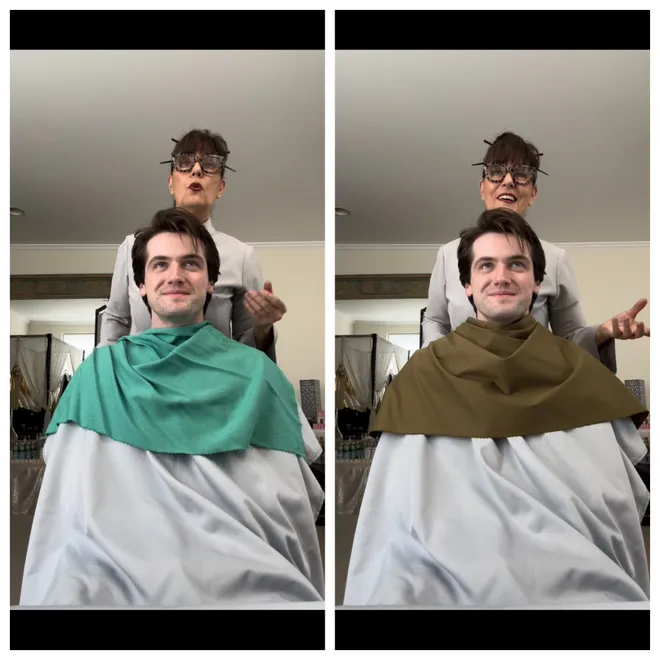Is ‘color analysis’ real? I put the viral TikTok phenomenon to the test − and was shocked.
LOS ANGELES − “Do you see the difference?”
I’m sitting in a chair looking at myself in a mirror. Over my gray apron, Brenda Cooper − a stylist, author and professional color analyst − drapes two different cloths of orange under my chin. One looks bright and strong; the other soft, muted. One, she says, harmonizes with my face. The other, not so much. In other words, one is my orange.
At this point in our color analysis, I’m squinting to see a difference. Cooper, however, warned me at the start of our session that would likely be the case. She says she couldn’t see a big difference when she first had her colors done many years ago. Now, she says, it stands out to her clear as day − and people subconsciously gravitate more toward her when she’s wearing her colors.
Color analysis, or the process by which you find your most complementary palette, is nothing new, emerging as a practice among stylists around the 1970s and ’80s − but it’s having a moment on TikTok right now, thanks to Gen Z, who are just discovering it.
Young people on TikTok go about color analysis in different ways. Some use filters and computer simulators. Others pay hundreds for appointments with professionals. Some even go so far as to travel to South Korea, where they insist the best color analysis happens.
Some of the color analysis videos are striking, showing people’s complexions brighten and skin tones even just by changing the color held under their chins. Some of them rack up millions of views − but also plenty of skepticism from commenters, questioning if editing or filters are at play. Others have conflicting feedback in the comments over which shade is actually best.
Cooper says wearing the right colors makes all the difference.
“It’s something that is very much overlooked, because people look at color, and they purchase or wear the colors they like to look at,” she says. “Wearing a color is a completely different thing. I often say that people fall in love with colors that aren’t in love with them.”
How does color analysis work?
Color analysis involves finding the palette of color that makes your face look the best, based on your undertones, veins and other subtle features. If your skin is “warm,” you’re either an autumn or a spring; if it’s “cool,” you’re either a summer or a winter. These seasons break down into further subtypes, such as dark autumn, bright winter and soft summer.
Mariana Marques, founder of The Outfit Curator, which offers in-person color analysis for just under $300, says awareness of color analysis has exploded in recent years.
“Two years ago, most people didn’t even know that that’s a thing that existed and that you could really do it,” she says, adding most of her color analysis clients are young female professionals.
Cooper says color analysis is indeed legitimate, but the effects turn up most profoundly in-person rather than online. Color has played a profound role in her work, she says. Cooper won an Emmy for costume designing the hit sitcom “The Nanny,” and she offers thorough, in-person color analysis in Los Angeles for over $800. Her clientele, she says, includes celebrities, surgeons and public speakers. (Fran Drescher, by the way, is a dark autumn, as is her other A-list client William Shatner, she says.)
Cooper, however, takes issue with the ways many young people go about color analysis online. She says a reliable color analysis requires a careful process of elimination, conducted in-person and under natural light.
Not everyone, she says, is initially happy when she tells them their best colors; however, she says it’s her job to deliver accurate information, and they can do with that knowledge what they wish.
Why does color matter?
The effect of color on how one is perceived is often overlooked but can be profound, color analysts say. Some colors drain you; some dominate you. Some colors harmonize with your natural beauty.
“Everybody’s skin tone can’t handle a certain color,” says Rayne Parvis, a style coach who has been doing color analysis for 14 years and charges nearly $1,000 for an in-person session. “I like to think of it as, if your soul wanted you to wear a certain outfit, this is how it would look.”
It’s also not as simple as red looks good, but green doesn’t. Everyone looks good in every color, but not in every tone of color. Think the difference between the yellow of a banana and the yellow of mustard. Or between black and charcoal.
“A lot of people think it’s going to be limiting, but I think it’s the opposite,” Marques says. “It’s not that you’re not going to have any shades of green in your palette. You just need to know the best green for you.”

My color analysis experience
Color analysis can have a profound emotional impact on people.
“Color is an electromagnetic energy, so we not only see it, but we feel it,” Cooper says. “When it’s done accurately, and a person sees themselves, even if they’re not classically beautiful, but sees themselves in their most attractive form, it can touch someone very emotionally. I’ve had many people with tears that just roll down their cheeks because they’re moved by it.”
At a different point in our session, Cooper asks if I see a difference between two shades of white under my face. I’m shocked that I do. One white − a stark white, the white of snow − washes me out. I see stubble more profoundly on my chin. Some red marks on my left cheekbone become visible. Even my lips look ever so slightly blue − “dead,” as Cooper says.
The white that’s a slight creme, however, is a different story. Dark circles under my eyes are less noticeable. My skin looks more even. Acne and red marks seem to fade. Is this real? Or is my mind, desperate to see something, playing tricks on me?
Cooper tells me I’m a true autumn, meaning my skin harmonizes with warm, fall colors. Brown loves me as does navy, she says. Black not so much, but charcoal is a different story. Guess I have to buy a new suit.
I’m curious to see how wearing these colors may or may not affect my life. Will I become more attractive? More magnetic? Or will just feeling like I am these things make the real difference?
“It’s not a superficial act at all. It’s your most public form of self-expression,” Cooper says of color. “The work that I do on the outside with people has a profound effect on their inner life in elevating their confidence and their self-acceptance so that they can go out into the world and take risks and do things that they wouldn’t normally do.”
文章来源:usatoday


TKFFF公众号
扫码关注领【TK运营地图】

TKFFF合作,请扫码联系!







 闽公网安备35021102002035号
闽公网安备35021102002035号